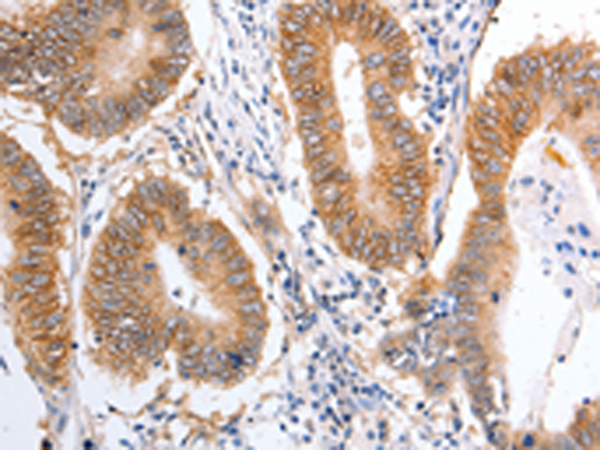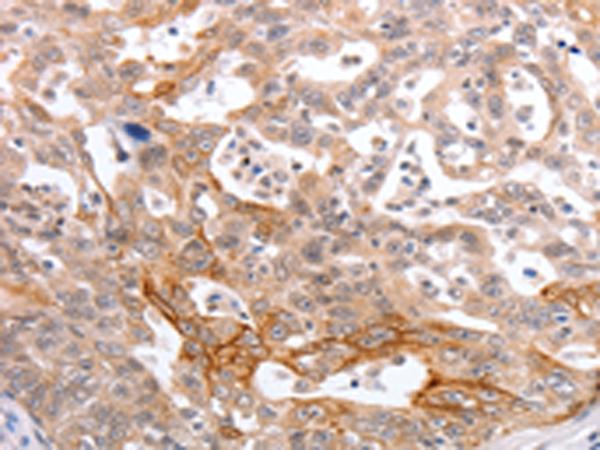

| WB | 咨询技术 | Human,Mouse,Rat |
| IF | 咨询技术 | Human,Mouse,Rat |
| IHC | 1/25-1/100 | Human,Mouse,Rat |
| ICC | 技术咨询 | Human,Mouse,Rat |
| FCM | 咨询技术 | Human,Mouse,Rat |
| Elisa | 1/1000-1/5000 | Human,Mouse,Rat |
| Aliases | HIWI, MIWI, PIWI |
| Host/Isotype | Rabbit IgG |
| Antibody Type | Primary antibody |
| Storage | Store at 4°C short term. Aliquot and store at -20°C long term. Avoid freeze/thaw cycles. |
| Species Reactivity | Human, Mouse |
| Immunogen | Fusion protein of human PIWIL1 |
| Formulation | Purified antibody in PBS with 0.05% sodium azide and 50% glycerol. |
+ +
以下是3篇关于PIWIL1抗体的代表性文献,按研究领域分类简要整理:
---
1. **文献名称**:*PIWIL1 Is Expressed in Seminomas and Ovarian Cancer Cell Lines but Not in Spermatogonia*
**作者**:Qiao D. et al. (2002)
**摘要**:该研究利用特异性PIWIL1抗体,首次揭示其在睾丸生殖细胞肿瘤(如精原细胞瘤)及卵巢癌细胞系中的异常表达,而在正常精原细胞中未检测到,提示其可作为生殖系统肿瘤的潜在标志物。
---
2. **文献名称**:*PIWIL1 Interacts with Hsp90 to Promote Cancer Cell Survival*
**作者**:Chen Y. et al. (2017)
**摘要**:通过免疫共沉淀(Co-IP)结合PIWIL1抗体,发现PIWIL1与热休克蛋白Hsp90直接互作,维持多种癌细胞存活,为靶向PIWIL1-Hsp90轴治疗癌症提供理论依据。
---
3. **文献名称**:*PIWIL1 Antibody Validation in Breast Cancer Stem-like Cells*
**作者**:Liu X. et al. (2020)
**摘要**:研究通过流式细胞术和免疫荧光验证PIWIL1抗体的特异性,发现其在乳腺癌干细胞亚群中高表达,且与肿瘤耐药性相关,提示其作为癌症干细胞靶向治疗的应用潜力。
---
**扩展建议**:若需更详细文献或特定技术应用(如WB/IHC参数),可进一步说明研究场景(如疾病类型或实验方法),以便精准推荐。
PIWIL1 (P-element-induced wimpy testis-like 1), also known as Hiwi, is a member of the PIWI protein family, which plays critical roles in germline development, stem cell maintenance, and RNA interference pathways. It is predominantly expressed in germ cells and some somatic stem cells, where it interacts with piRNAs (PIWI-interacting RNAs) to regulate transposon silencing, genome stability, and epigenetic programming. Dysregulation of PIWIL1 has been implicated in various cancers, including germ cell tumors, gliomas, and gastrointestinal cancers, where its abnormal expression often correlates with poor prognosis and tumorigenesis.
PIWIL1 antibodies are essential tools for studying its biological functions and pathological roles. These antibodies are widely used in techniques like Western blotting, immunohistochemistry (IHC), immunofluorescence (IF), and flow cytometry to detect PIWIL1 expression patterns in tissues, stem cells, or cancer samples. Specificity and validation are critical, as PIWI family members share structural homology, requiring antibodies to distinguish PIWIL1 from paralogs like PIWIL2-4. Researchers also utilize PIWIL1 antibodies to explore its interactions with piRNAs or other proteins, aiding in mechanistic studies of germ cell development, stem cell self-renewal, and cancer progression. Despite challenges like cross-reactivity and limited expression in normal somatic tissues, these antibodies remain pivotal in advancing reproductive biology, oncology, and regenerative medicine research.
×